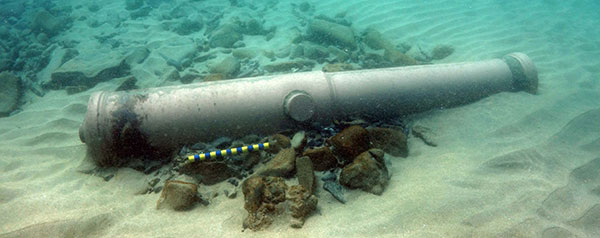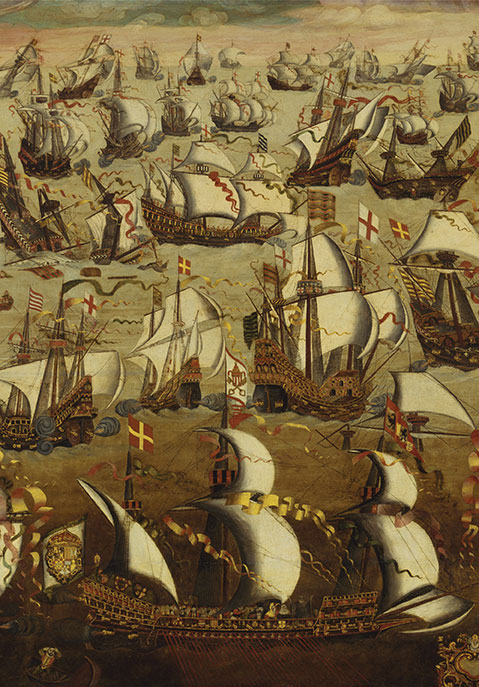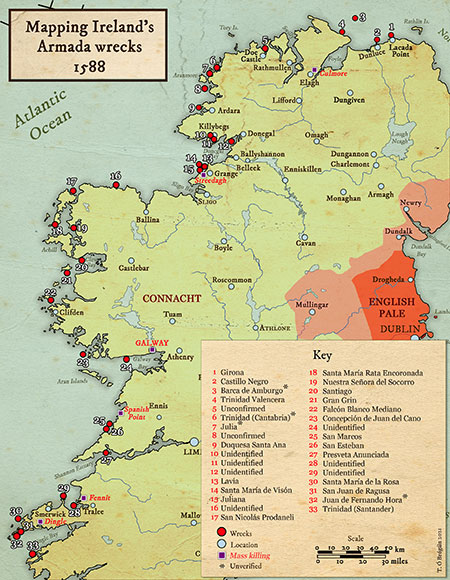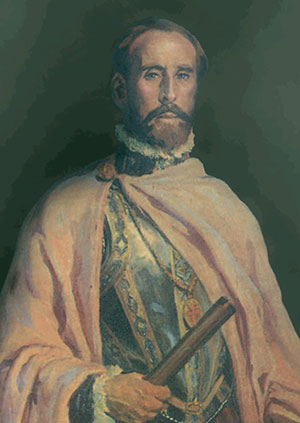Spanish Armada wrecks on the Irish coast
Published in Features, Issue 5 (September/October 2021), Volume 29By John Miles
La Trinidad Valencera of the Spanish Armada was in trouble. The ship weighed 1,000 tons and had a complement of 360 men. She was leaking badly and had taken on more water than could be pumped out. Nevertheless, as she approached the Irish coast, she managed to rescue 264 men from another Spanish ship swamped in the heavy seas. The Trinidad made anchor in Kinnagoe Bay, Co. Donegal (4), where she was listing to such a degree that the order was given to abandon ship. (Artefacts recovered from this wreck are on permanent display in Derry’s Tower Museum.) Some locals were paid for the use of a small boat, and over the course of two days more than 560 men were ferried safely to shore.
After a seven-day march inland, the survivors met a force of English cavalry. Upon pledges of safe conduct for their delivery into the custody of the Crown, the Spanish laid down their arms near Ellagh Castle. The noblemen and officers were then separated out, but 300 of the common seamen learned a harsh lesson about trusting the word of English officials and were summarily executed between Ellagh and Culmore fort. Roughly 150 Spaniards broke free and fled through a bog, ending up either with Sorley Boy MacDonnell at Dunluce or at the house of the bishop of Derry. From there they were eventually sent to neutral Scotland to seek repatriation to Spain. The 45 Spanish noblemen and officers were force-marched more than 200km to Dublin, but only 30 survived to reach the capital. From there, they were dispatched to London to await ransom from Spain.
The Spanish plan and why it failed
The reason why Spaniards were shipwrecked in Ireland can be explained by the political events occurring on the continent of Europe. By spring 1588, King Philip II of Spain had grown weary of Queen Elizabeth I’s interference in the civil unrest in the Spanish Netherlands. He decided that an invasion of England was the surest way to resolve the issue. Accordingly, he assembled a fleet of 130 ships, with 20,000 men and 2,500 cannons. The fleet was so large that it took two days for it to leave its ports on the Iberian Peninsula. The plan was for the fleet to embark a 30,000-strong Spanish army already in the Spanish Netherlands, sail across the English Channel and invade England. Upon learning of the Spanish plans, Elizabeth assembled her own fleet of 200 ships to oppose them. While the English fleet outnumbered the Spanish, it was less well armed. The English ships, however, were faster and more manoeuvrable than the bulky Spanish ships, many of which were converted merchantmen. The English battle plan was to use this to their advantage.
In July 1588, on entering the English Channel, Spain’s armada was attacked by the English naval force. During eight hours of furious fighting, Spain’s tactical and technological inferiority to the English became apparent. Many of the Spanish cannons were heavier than the English ones, but they were also obsolete. Spanish metalworking capabilities lagged behind England’s to the point that Spanish cannons resorted to firing 25-pound rocks at the British. These rock-shooting cannons were powerful at short range but not at long range. The English were aware of this and kept their distance. The English also possessed specially designed naval gun-carriages that allowed the guns to be pulled in and reloaded more quickly. The Spanish possessed none of those and some of their cannons could only be reloaded in port. After losing five ships to English cannon fire, a change in wind direction forced the Spanish to break off and head towards the North Sea. Its hopes of a successful invasion now crushed, the Spanish Armada undertook a long and arduous journey back to Spain.

Above: A cannon from La Juliana, which sank off the coast of Sligo (15). (National Monuments Service)
After the sea battle, the commanders of the Armada held a conference on the admiral’s flagship about how best to sail home. The admiral made his choice and issued his orders. The fleet was to approach the coast of Norway before steering west towards the Shetland Islands and on to Rockall, an uninhabited granite islet in the North Atlantic. This would allow passage around the northern tip of the Shetlands, clearing the coast of Scotland. Once clear of Scotland, the ships were to steer to a position 650km beyond the Shannon estuary, on the west coast of Ireland, giving themselves a clear run south back to Spain.

Above: Detail from The Spanish Armada and English Ships in August 1588. (National Maritime Museum, Greenwich)
Alarm in Dublin
While the Spanish were debating how best to return home, the English were preparing to counter what they believed was still an imminent amphibious landing. The head of the English government in Dublin was Lord Deputy William Fitzwilliam. In August 1588 he was presented with credible intelligence that the sea battle in the English Channel had been won by the Spanish and that the invasion of England was about to begin. Then he received further intelligence that the Spanish fleet was about to invade Ireland instead. The degree of alarm among the English in Dublin was intense. Fitzwilliam initially feared that the Spanish would land in disciplined formations, with many Irish rising to join them from territories that were essentially beyond the control of the government. Eventually, reliable intelligence was received that the ships were instead landing in a chaotic manner along hundreds of kilometres at disparate locations on the coasts of Ulster, Connacht and Munster. Fitzwilliam feared that the Spanish were landing in a distributed manner over a large area to try and ferment a nationwide Irish rebellion, so he ordered that all Spaniards captured be hanged summarily. He also stipulated that anyone aiding them would be tortured and charged as a traitor to the Crown.
 Impossible sailing orders
Impossible sailing orders
The Spanish admiral’s sailing orders were almost impossible to follow. The weather was difficult. The navigators’ charts were primitive and focused on the English Channel, and thus were of little use. Moreover, most of the ships’ navigators lacked training and experience in the techniques of dead-reckoning and latitude sailing, which was what was needed to return them safely to Spain. The Armada failed to sail its course around the north of Shetland. Instead, it passed to the south, between Orkney and Fair Isle. From there it was supposed to voyage around the Hebrides until it caught sight of the distant islet of Rockall, but prevailing southerly winds stirred up an anticyclone, preventing the fleet from running west-south-west as ordered.
The sailing orders were rendered useless by the weather, but miscalculations of the Armada’s position also contributed greatly to its destruction. The navigators were unaware of the effect of the North Atlantic Drift, a current that flows in a north-easterly direction. It surely hindered the fleet’s westward progress, perhaps by as much as 30km a day. This meant that when the ships’ navigators estimated how far they had sailed west each day, they overestimated by at least 25km. It is probable that the Armada’s actual position as it turned south to head for home was entirely wrong, by almost 500km. The Armada thought that it was well to the west of Ireland but its actual position was further east, perilously close to the rocky coasts of Scotland and Ireland.
Many Spanish ships were sighted off the coast of County Clare, including four at Loop Head, two of which were wrecked, the 700-ton San Esteban at Doonbeg (26) and the 800-ton San Marcos at Lurga Point near Seafield, Quilty (25). All of the several hundred survivors were put to death by the sheriff of Clare, as per Fitzwilliam’s orders. The executions most likely took place at Cnoc na Crocaire, Spanish Point.
Juan Martínez de Recalde

Above: Armada commander Juan Martínez de Recalde had prior experience of the Irish coast, which he put to good use in and around the Blasket Islands. In 1580 he had landed a 600-strong papal invasion force on the Dingle peninsula; they were subsequently massacred at Smerwick harbour.
One Armada commander, Juan Martínez de Recalde, did have prior experience of the Irish coast. In 1580 he had landed a papal invasion force on the Dingle peninsula, leading to the siege of Smerwick and the massacre of the 600-strong force; Recalde managed to evade an English squadron of warships afterwards and return home.
After the Armada’s defeat, Recalde’s galleon led another ship, the San Juan de Bautista, to the coast of Kerry. Recalde’s lookouts saw Mount Brandon on the Dingle peninsula and, towards the west, the Blasket Islands. Recalde steered to the islands in search of shelter, sailing through a tight gap at the eastern tip of the Great Blasket Island. His galleon made it through to calm water and anchored. The San Juan soon followed. It had been an exceedingly difficult sailing manoeuvre, requiring prior knowledge of the coastline and Blasket sound.
Recalde’s ships remained within their shelter for several days, and a Crown force arrived in Dingle to guard against a landing. Recalde sent a reconnaissance party ashore, but all eight were captured. Another ship, the 900-ton Santa Maria de la Rosa, appeared in the sound and fired off a gun by way of a distress signal. Recalde’s ships held their anchorage in the more sheltered part of the sound, while the Santa Maria drifted and then sank, perhaps upon striking Stromboli Rock (30), leaving one survivor for the English to interrogate. The survivor claimed that the captain of the vessel had called the ship’s pilot a traitor and run him through with a rapier just as the ship began to sink. He also asserted that the son of the king of Spain had gone down with the ship. That information was false but proved to be useful propaganda for the English.
Two more ships entered the sound, the San Juan de Ragusa and an unidentified vessel. The de Ragusa was in distress and sank, perhaps upon striking Dunbinna reef (32). A third ship, the San Juan de Bautista, used an ebb tide to sail south out of the sound and finally escaped, making it home to Spain after a terrible storm. After three days Recalde led the remaining ships out of the sound and brought them to Spain. Those survivors who had fallen into Crown custody were put to death at Dingle. Another ship, the Trinidad, was wrecked off Valentia Island (33). There were no survivors of the 300-man crew and no witnesses to the wreck.
La Girona—greatest loss of life
Among those ships wrecked in Connacht was the La Rata Santa Maria Encoronada, carrying over 400 men. She had run for the Irish coast in desperate need of repair, along with several other vessels. La Rata carried an extraordinarily large number of noblemen from the most ancient families of Spain, as well as the son of the Irish rebel James Fitzmaurice Fitzgerald.
La Rata sailed along the north coast of Mayo and around the Belmullet peninsula, anchoring in Blacksod Bay. The wind rose and the ship dragged her anchors, until she was grounded on Ballycroy strand (18). Most of the crew got ashore and seized two castles, garrisoning them with stores from the beached ship, which was then burned. The rebel’s son, Maurice Fitzmaurice, had died on board, and his body was buried at sea in a cypress chest. Several days later, two ships of the Armada entered Blacksod Bay, the Duquesa Santa Ana and another. The several hundred stranded Spaniards boarded the Duquesa. The other ship promptly sailed for Spain, safely arriving sometime later. The Duquesa, however, was somewhat weather-damaged and it was decided to sail north for Scotland. Turbulent weather hit and she was grounded in Loughros Bay, Co. Donegal (9), with all aboard reaching shore in what was friendly territory.
The crew made camp on the shore for nine days, until news came that another ship, La Girona, had anchored in Killybegs harbour. MacSweeney Bannagh, the local Irish chieftain, aided the Spanish; the Girona was repaired and set sail with 1,300 men on board, including the survivors from the Duquesa and two other ships that sank in Killybegs harbour. Unfortunately, another gale struck and her rudder failed again. La Girona was driven ashore at Dunluce, Co. Antrim, off Lacada Point (1). There were only nine survivors, who were sent on to Scotland by Sorley Boy MacDonnell. Over the next few days, 260 Spanish bodies washed ashore. This was the greatest loss of life from a single ship.
Final toll
All told, approximately 33 ships of the Grand Armada were lost on the Irish coast, accounting for more than half of the fleet’s total loss of 63 vessels (nearly half the Armada’s total of 130). Thousands of Spanish sailors (including an estimated 2,000 who were Irish) were either drowned or executed as per orders of the Crown. The first salvage attempts were made within months, on the coast of County Clare by George Carew, who complained about the expense ‘of sustaining the divers with copious draughts of usequebaugh’. Sorley Boy MacDonnell recovered three brass cannon and two chests of treasure from the wreck of La Girona. In 1797 a quantity of lead and some brass guns were raised from the wreck of an unknown Armada ship at Mullaghderg, Co. Donegal (7). Also in Donegal, in 1853, an anchor was recovered from another unidentified Armada wreck at Cloughglass near MacSweeney’s castle (8). And in the summer of 2014 an initiative to locate the remains of the San Marcos commenced operations between Mattle Island and the Curragh Shoal, Co. Clare (25). This initiative, called the San Marcos Project, assembled a group of academics, scientists and divers to employ cutting-edge search and survey techniques.
John Miles is a US Marine Corps Lt. Col. (retired), published author and historical presenter.
FURTHER READING
V. Fenwick & A. Gale, Historic shipwrecks (Cheltenham, 1998).
T.P. Kilfeather, Ireland: graveyard of the Spanish Armada (Dublin, 1967).
C. Martin & G. Parker, The Spanish Armada: revised edition (Manchester, 2002).
















